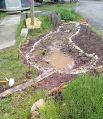Wetlands are rich and diverse landscapes in the water-land interphase. They provide many ecosystem services to people as well as habitats to flora and fauna. Created wetland is a term used for newly built wetlands which are designed to provide both multiple ecosystem services and habitats supporting high biodiversity. We will study the theory behind and learn the design process of created wetlands. To enrich the learning experience, and to support the planet one wetland at a time, we will design and hands-on implement a small new created wetland as a piece of living environmental art.
Outi Wahlroos is an environmental scientist (Ph.D. in Environmental Toxicology), ecological engineer (M.Sc. in Biological and Environmental Engineering), and ecological designer (M. of Landscape Architecture). She has 10 years of experience in molecular biology followed by 25 years in water environment protection with nature-based methods. She has carried out academic research on ecosystem services provided by her pilot created wetlands. As a professional practitioner she has designed multiple nature-based mitigation landscapes from holistically designed urban watersheds to stream and flood forest restoration, to green roofs and many kinds of created wetlands.
Preliminary plan
Day 1 (Thursday), 25.04.2024, seminar room, M7b, room 204
9:15 lectures
10:45 walk to see the existing wetland; walk to see the student garden, put marks on land and measure dimensions for wetland; introduce materials
12:30 Break
13:30 Setting up test puddles in small containers
15:00 Free time/Homework: making draft designs on paper
Day 2 (Friday), 26.04.2024, seminar room, M7b, room 204
9:15 review designs in class (choose which ones to implement, joint effort!)
10:45 work on the designs in the student garden; discussions during work
12:30 Break
13:30 continue work in the garden
Day 3 (Saturday), 27.04.2024, seminar room, M7b, room 204
10:00 Discussion
10:45 work on the designs in the student garden; discussions during work
12:30 lessons learnt, feedback
13:00 End of the workshop
Design process
Goals -> Set goals, review after site and watershed analysis
Site analysis and watershed analysis -> Land-use, topography, climate, soil type, land cover, water quantity&quality
Conceptual plan -> What interventions, how are linked together
Design draft -> Review draft with stakeholders
Implementation design -> Details ready for construction
Implementation - Meetings with constructor
Monitoring -> Monitor for set goals
Maintenance - Maintain goals and allow site succession
How much water comes to the puddle?
- Q = 0,0028*C*|* A
- Q = peak inflowing stormwater runoff rate [m3/s]
- C = runoff coefficient: the proportion of rain that turns to runoff
- I = intensity of the design storm [mm/h]
- A = area of watershed from which water is collected [ha]
- (0,0028=(mm/h)* (1m/1000mm)* (1h/3600s)* (ha)* (10.000 m2/ha)) (1 m3/s = 1000 |/s)
- design storm = intensity for known duration and return period
- OR: Q=CIA I/s, I = I/(s* ha), A= ha
Options for measurements
List of available sensors: https://docs.google.com/spreadsheets/u/0/d/1-nHI2IY6cZU3KNQGhrMeyQNFAp5hKw8zHxmQYMS9Fj8/htmlview
- Phosphorus
- Turbidity (inflow is turbid / measuring light)
- Surface area and water shed
- Ph, nitrate, temperature
- Daphniometer
- Chromatography - sasa spacal / https://artlaboratory-berlin.org/exhibitions/terra-xenobiotica/
- Compare roof water, tank water, pond water
- Cress
- Vegetation (increase herbaceous species)
- Set cameras for time lapse
- Take photos from the same spot at certain time
Slides
Wetland diary
13.05.2024
Natalia: today i see insects in the pont such as wasps, many wasps, which i guess is a good signal. There is a plant that have a few flowers. the soil is very dry but the parts of them that have water are looking pretty good, i see some bubbles coming from the ground. about the tank there is no more water there
06.05.2024
05.05.2024
03.05.2024
01.05.2024
29.04.2024
28.04.2024
27.04.2024
The plants planted in the Student Garden pond were:
Alisma plantago-aquatica, Gewöhnlicher Froschlöffel**
Caltha palustris, Sumpfdotterblume*
Lobelia cardinalis, Kardinal-Lobelie*
Lythrum salicaria, Gewöhnlicher Blutweiderich*
Mentha aquatica, Wasserminze*
Mysotis palustris, Sumpf-Vergissmeinnicht*
Scirpus cernuus, Frauenhaargras***
Water depth range:
*0-15 cm
**0-40 cm
***0-100 cm
All the plants do well in wet meadow conditions, which occur in stormwater ponds during less rainy seasons. The light small rock layer on top of the soil is meant to help the soil layer stay moist during dry seasons. Since the wetland is small and the watershed is small - and water does not necessarily go to the wetland from the roof when it rains - one has to take care of the wetland and water when the weather is hot and dry. (Big wetlands with big watersheds are carefree in this aspect, we did not have a choice of a self-sustaining site).



































